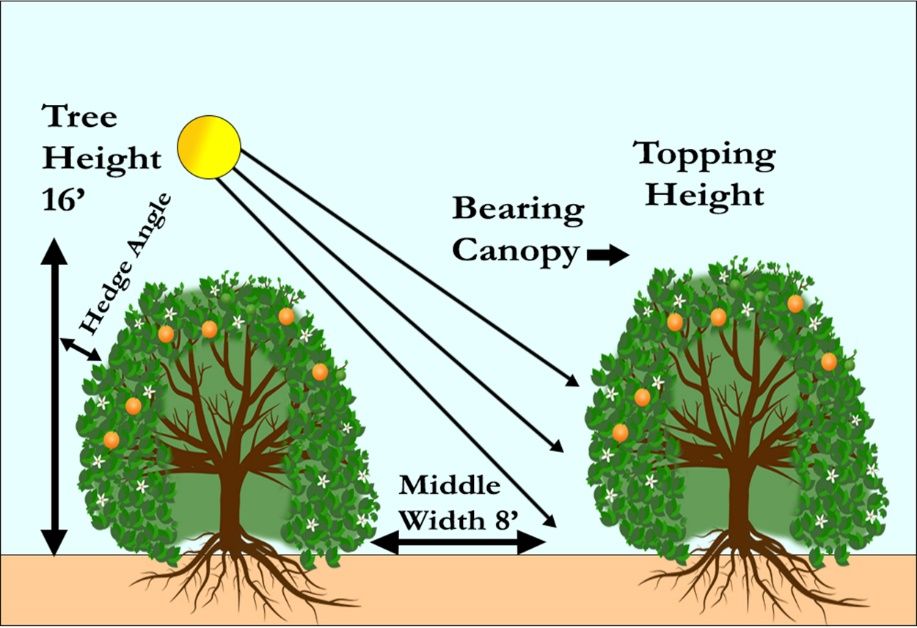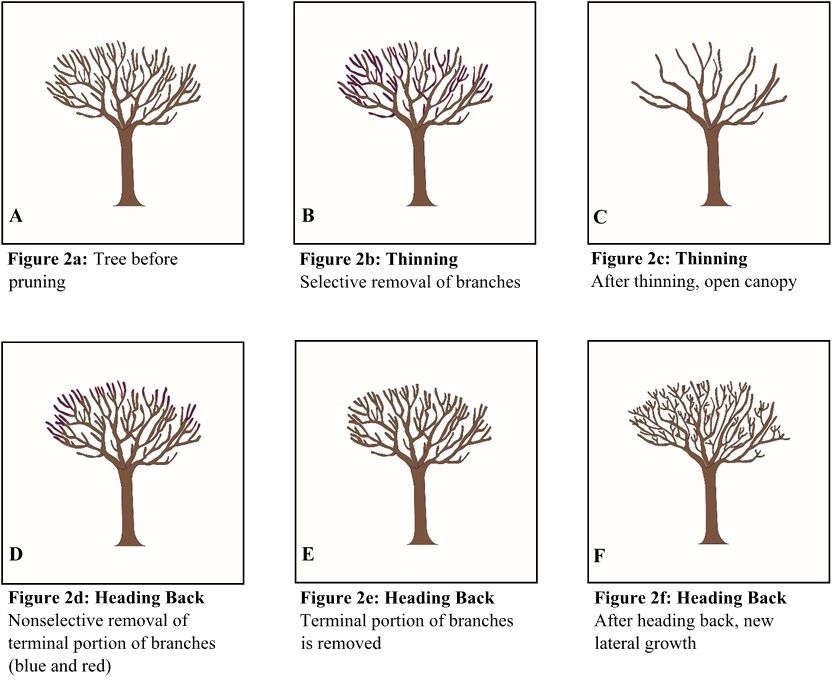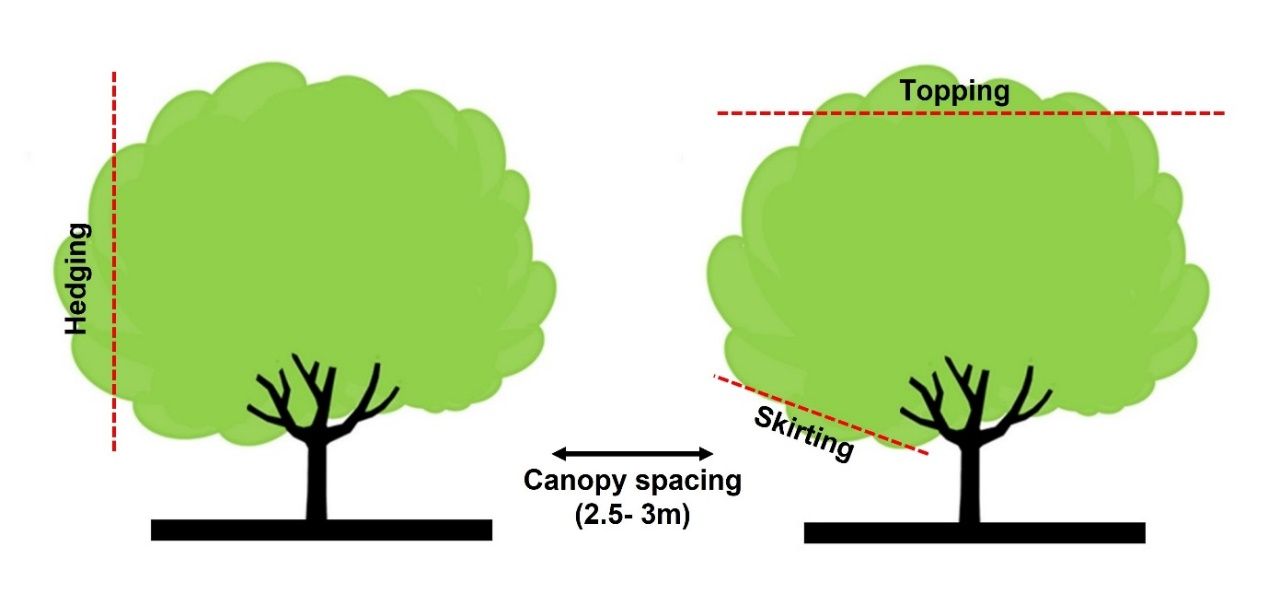Tree canopy and bearing volume are two important factors in fruit production and fruit quality. Generally, trees with larger canopy and bearing volumes produce more fruit than smaller-canopy trees. Canopy management is an important aspect of citrus production in Florida to avoid problems associated with overcrowding and excessively tall trees, to improve light interception, and to improve pesticide distribution into the canopy, as well as to facilitate equipment operation within the grove. Proper control of vegetative growth is essential for the maintenance of healthy, productive citrus trees. The effect of insufficient light is frequently observed in mature citrus groves that are not managed regularly. Shading reduces yield and foliage on the lower parts of the trees. Sunlight not only influences flowering and fruit set but also enhances fruit quality and color development. Increased sunlight penetration within the tree canopy might also allow foliage to dry more quickly after a rain shower and could help reduce establishment of fungal pathogens. Therefore, adjustments must be made to the tree canopy to maximize sunlight interception.
Pruning is one of the oldest horticultural practices that changes the form and growth of a tree. The pruning process (1) adjusts tree shape and the ratio of the framework to the fruit-bearing shell of the canopy, (2) alters the shoot/root ratio, and (3) changes the carbohydrate (food storage) status of the tree. Pruning healthy, mature citrus trees can reduce yields in proportion to the amount of foliage removed and can delay fruiting of young, nonbearing trees. Pruning should therefore be limited to that required for future canopy bearing-surface development and to conduct efficient cultural and harvesting operations (Figure 1). Under Florida weather conditions, citrus trees often produce vigorous vegetative growth, which can result in overcrowding and shading. Therefore, canopy management is very important. In general, tree response to pruning depends on several factors, including variety, rootstock, tree age, growing conditions, time of pruning, and production practices. There is no fixed set of rules, and therefore each situation should be critically analyzed before any severe canopy management decisions. Growers are encouraged to gain a clear understanding of the basic principles regarding pruning and to take advantage of research results as well as to consult knowledgeable colleagues and custom operators for their observations and recommendations.

Credit: UF/IFAS (adapted from EDIS HS1026)
What to Do before Pruning
The correct use of equipment tools is very important before pruning. There are several pruning tools available like loppers, scissors, saw pruners, hedge shears, and trimmers. Keep the tools sharp and in good working condition and remember to disinfect the tools before and after use every time to prevent the spread of disease among trees. Sterilize your pruning tool when moving from one plant to another one. It is better to sanitize with alcohol, 5% bleach, or disinfectant instead of heating.
When and How to Prune
Time is very important for pruning, and it varies with the type of scion and rootstock. Prune at the time that best complements plant growth, its characteristics, flowering, or any other objective you desire to achieve. Early spring is the best time for pruning in most fruit-bearing trees including citrus. Pruning in citrus too early may stimulate new growth, but if a late freeze event occurs, it can cause serious damage. Always prune back to or just above the branch or bud growing point.
Basic Pruning Cuts
Thinning out and heading back are the main types of pruning cuts (Figure 2). Thinning out is a selective pruning method that involves the removal of complete branches down to the main trunk and is often done with handheld equipment. It encourages longer growth of the remaining terminals and can result in a more open tree, which allows more sunlight to penetrate deeper into the tree canopy. Thinning out is commonly seen in peaches and plums to maximize light penetration into the inner canopy for better fruit set and growth. This type of pruning is generally considered too labor intensive and costly, and therefore it is not commonly practiced in the Florida citrus industry. Heading back removes the terminal portion of a shoot or branch, removing apical dominance and stimulating lateral bud breaks (Figure 2). As a result of heading back, trees are more branched and compact. Mechanical hedging and topping are the main forms of mass heading back used in Florida for mature trees.

Credit: Tracy Bryant, UF/IFAS Communications
Canopy Management for Young Trees
Severe pruning and training of young, nonbearing trees tends to delay fruit production and should be avoided. Most trees usually need no pruning for the first few years in the grove except for removal of sprouts on the trunk. Larger sprouts should be cut off flush with the trunk to avoid dominance over a weaker tree. Sprouting on the trunks of young, nonbearing trees can be greatly reduced by using a commercial sprout inhibitor containing naphthaleneacetic acid (NAA; refer to chapter 19, “Plant Growth Regulators”). While protective wraps around the trunk will reduce sprouting, careful monitoring and observation is required to avoid insect and disease problems under the wraps.
Canopy Management for Mature Trees
When mature trees begin to overcrowd, growing tall and into the row middles, canopy management becomes essential to maintain tree size and improve light penetration. Hedging and topping are very common cultural grove-management practices in Florida (Figure 3).
Hedging and Topping
Hedging consists of cutting back the sides of trees to prevent or alleviate crowding. Hedging produces numerous cut wood surfaces along the side of the tree canopy from which new sprouts arise, eventually developing into a wall of new foliage. Middles (alleys) between tree rows should be sufficiently wide to accommodate grove equipment and provide adequate light access to the sides of the trees. Middles are usually hedged to a width of 7 to 8 ft but will vary depending on original grove design, scion variety, rootstock, and equipment used in all production practices.
Hedging should be completed before canopy crowding becomes a problem. As a general rule of thumb, pruning of branches greater than 0.13 to 0.25 inch (1/8 to 1/4 inch) in diameter should be avoided. Developing a proactive pruning program should assist managers in removing the right-sized branches. Removal of a significant portion of the tree will result in excessive vegetative growth and a drastic reduction in subsequent yield. Hedging is usually done at an angle, with the boom tilted inward toward the treetops so that the hedged row middles are wider at the top than at the bottom. This angled hedging allows more light to reach the lower skirts of the tree. Commonly used hedging angles vary from 10 to 15 degrees from vertical.
Topping should be done before trees have become excessively tall and should be an integral part of a tree-size maintenance program. Long intervals between toppings increase the cost of the operation due to heavy cutting and more brush disposal.
Furthermore, excessively tall trees are more difficult and expensive to harvest and spray. Topping trees will improve fruit quality and increase fruit size while reducing management and harvesting costs. Some common topping heights are 12 to 14 ft at the shoulder and 16 to 17 ft at the peak. Generally, topping heights should be two times the row-middle width.
Lower heights are sometimes used for training trees, increasing fruit size, or rejuvenating declining trees, or after flooding events that damaged the root system. Taller trees are sometimes maintained when they are vigorous and widely spaced. Trees in the flatwoods areas are generally topped lower than those on the ridge because the more limited root systems will usually not support as much top growth. Topping should be started before extensive cutting is required. If heavy cutting is required, the initial cuts should be low enough to avoid cutting excess wood in subsequent topping operations. Retopping is generally done just above the old cut.
After severe hedging or topping, heavy nitrogen applications will produce vigorous vegetative regrowth at the expense of fruit production. Therefore, nitrogen applications should be adjusted to the severity of hedging or topping. Reducing or omitting a nitrogen application before and possibly after heavy hedging will reduce both costs and excessive vegetative regrowth. Light maintenance hedging should not affect fertilizer requirements or application.
Large crops tend to deplete carbohydrates and result in reduced fruit yield and increased vegetative growth the following year. Pruning after a heavy crop additionally stimulates vegetative growth and reduces fruit yield the following year. Pruning after a light crop and before an expected heavy crop is recommended because it can help reduce alternate bearing, which can be a significant problem in Pineapple orange and Murcott production.
Severe hedging may create problems of brush disposal and stimulates vigorous new vegetative growth, especially when done before a major growth flush. This happens because an undisturbed root system is providing water and nutrients to a reduced canopy area. The larger the wood that is cut, the larger the subsequent shoot growth. Severe pruning reduces fruiting and increases fruit size.

Credit: Muhammad A. Shahid, UF/IFAS
Canopy Management Program
The best time of year to hedge or top depends on scion variety, grove location, severity of pruning, and availability of equipment. Because pruning is usually done after removal of the crop, early-maturing varieties are generally hedged before late-maturing varieties. Most growers prefer to hedge before bloom, but trees will get more vegetative regrowth, which may not be desirable. Pruning could begin as early as November prior to harvesting in warmer areas. During this period, pruning operations should only cut minimal foliage and fruit from the trees.
Valencia trees may be hedged in late fall with only minimal crop reduction when the hedging process removes only a small amount of vegetative growth. In cases where excessive growth is to be removed, the trees are usually harvested before hedging is conducted. Light maintenance pruning can be done throughout the summer and until early fall with little or no loss in fruit yield. Moderate to severe pruning should not continue into the winter in freeze-prone areas, because trees with tender regrowth are susceptible to cold injury.
Tree Skirting
Skirting is a pruning practice to raise tree skirts. Without skirting, the movement of herbicide booms, fertilization (in wetted zones), and mechanical harvesting equipment is impeded. Fruit and limbs near the ground are often damaged by the passage of such equipment and by herbicide spray and fertilizer contact. Skirting allows uniform distribution of granular fertilizers and improved water coverage of microsprinkler irrigation systems under tree canopies. The practice facilitates the inspection of microirrigation systems and reduces the incidence of phytophthora foot rot and brown rot because it also allows good air circulation.
Canopy Management and Huanglongbing
Because Florida groves have become heavily affected with huanglongbing (HLB) and the psyllid population has been on continuous increase, selecting the best time for hedging and topping is becoming more complicated. New growth flushes promoted by hedging and topping in late spring, summer, and early fall can increase the population of leafminers and psyllids and aggravate the spread of HLB. HLB-affected trees often undergo severe root loss; therefore, these trees can be hedged and topped to help balance the shoot-to-root ratio to improve tree performance and extend tree longevity. However, buckhorn pruning or severe pruning of HLB-affected trees is not recommended. Such practices have been found to not be economically viable; a significant reduction in yield should be expected in years one and two following severe/buckhorn pruning. Severe pruning can also result in reduction in root density for up to three years.